More about the Thinking Machine
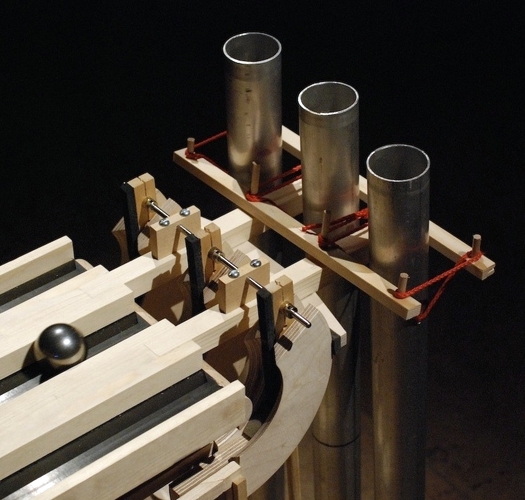
The ball is about to operate a hammer and play a tubular bell.

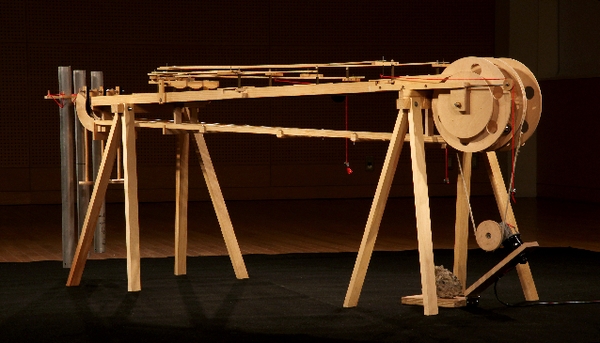
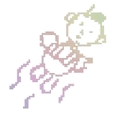
|
|
Dear Klarenz, My dream comes true! Unbelievable but I saw the Thinking Machine working!! The machine performs the trinary operation Jaiken-zan and plays tubular bells as its result. Liebe Gruesse aus Berlin, Masahiro |

at TESLA-Berlin |
How did the project start? Prof. Hermann Gottschewski of Tokyo University introduced me to the composer Masahiro Miwa. Miwa-san had previously formulated and tested the algorithm and now proposed that I should build a machine to play it. Our communication was entirely by e-mail; we finally met when the project was almost complete (at TESLA-Berlin where I had a residency) while I was making the final adjustments to the machine. Why "Thinking Machine" ? Miwa-san and Prof. Gottschewski sat down together to make an application for funding the project and they thought up this title in the context of other machines I have made - like the Flute Playing Machine and the Talking Machine. Yes, it does seem a rather grandiose title for what is a relatively simple mechanism. Nevertheless, if I try to predict the next two or three notes that the machine will play I find that I have to think quite hard about it. |
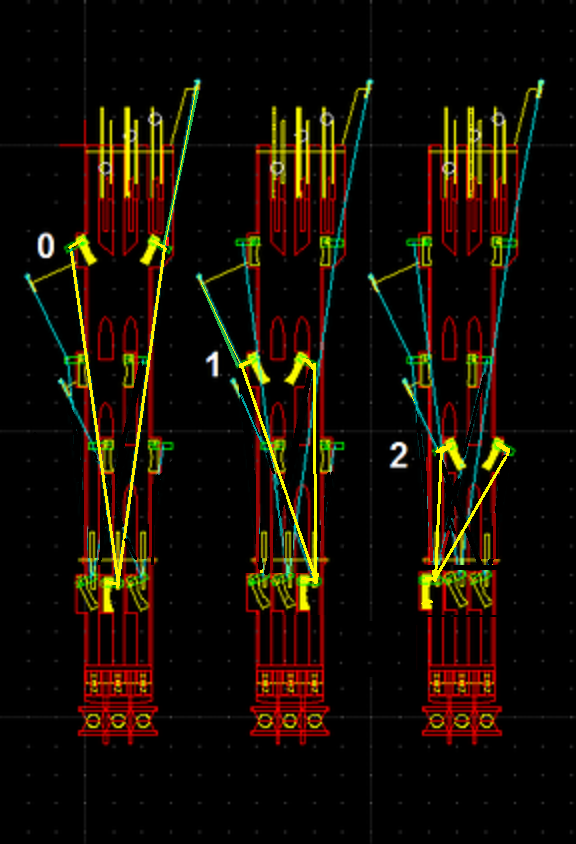
The three states of the machine: 0, 1, 2 In each state a pair of highlighted levers (numbered) has been just been activated by a ball passing through a gate (below.) A highlighted lever will control the course of the new ball. |
What is the algorithm? The machine works with a succession of 6 rolling balls that circulate, one after the other, through the machine and each plays one of three bells. New A = (6-(Old A + State)) MOD 3 where Old A the track through the ball enters: 0, 1 or 2 State the current way the mechanism is set: 0, 1, or 2 New A the track through the ball exits to play a bell: 0, 1 or 2 To express this formula in a different way, here is the truth table. State is the top line, Old A is the column on the left; join them up and you get New A
0 1 2
0 0 2 1
1 2 1 0
2 1 0 2
|
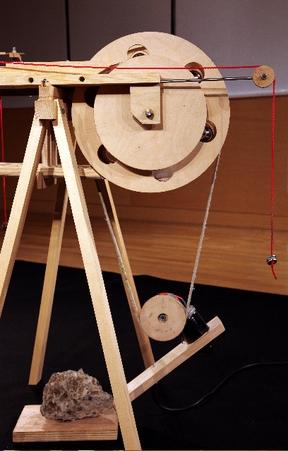
The wheels and its driving motor, anchored to the floor by a stone. |
What are the three wheels for? They serve as a memory (a shift register). The wheels store the results of the five previous runs. Without this memory function I would have had to make a circle of 6 machines, passing around a single ball to each other - as in Masahiro's original Reverse Simulation performance with 6 players. My shift register inspired Masahiro-san to make a new version of his piece with a simulated shift register for live players. (This is well explained in the video link at the bottom of this page). |
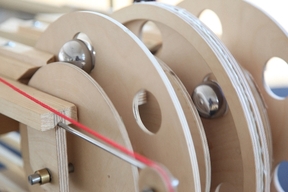
The three wheels: 0, 1, 2 |
How is the machine started (initialised)? The 6 balls are loaded by hand into the wheels in a particular pattern. For example: 000001. That means 5 balls in the left wheel (value 0) and then one in the middle wheel (value 1). None in the right wheel (value2). That particular combination will result in a run of 52 turns of the wheels, resulting in 312 notes (52 x 6) before there is a repeat. 001022 repeats after 8 turns of the wheels, while 111111 would repeat continuously. |
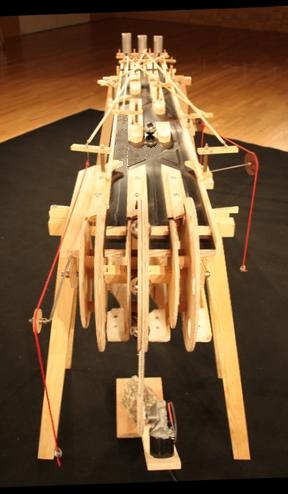
View from the wheels towards the bells |
What happens after a ball leaves the wheel? The ball is guided down the track by pairs of levers that are operated by gates at the end of the track. Thus, each ball determines the course of the ball that follows. In the photo the first pair of levers have been activated by the previous ball. The levers are connected to the gates by long wooden rods. The small weights on the ends of the red strings pull the levers gently back out of the way after they have been released. |
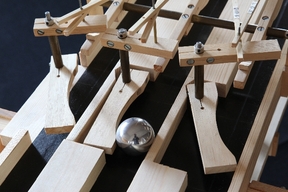
A ball switching the middle gate. |
How do the gates work? When the ball arrives at the gates it first releases all the gates and then switches the gate that it passes through - here the central gate. This positions the levers that determine the course of the following ball. |
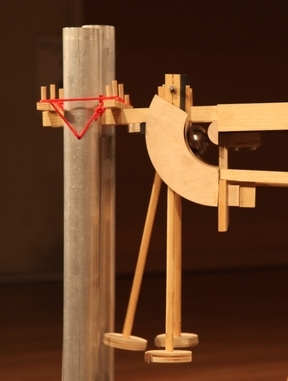
The hammer mechanism |
And then ... ... as the ball plunges over the end of the track it deflects a hammer which strikes the bell a gentle blow. The bells are suspended at about 1/5th of their length from the top. The hammer strikes the bell at its sweet spot - somewhere in the middle. |
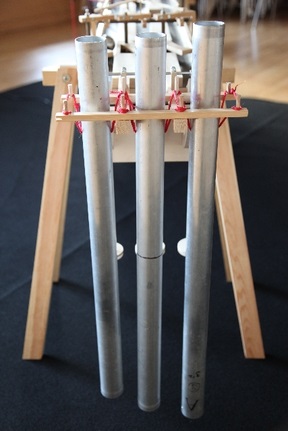
The tubular bells. Behind them, the hammers |
Why tubular bells? I wanted instruments with a long sustain that would fill out the 5-second pauses between each note and would have a different timbre to the clicking sounds of the mechanism. The bells are tuned A, B and C. I also experimented with a combination of three different instruments: a tubular bell, a rattle with a very long sustain (like a vibro-slap) and a hollow block of light wood (like a temple block). But when I got them running they sounded too intentionally East Asian, so I reverted to my 3 tubular bells. |
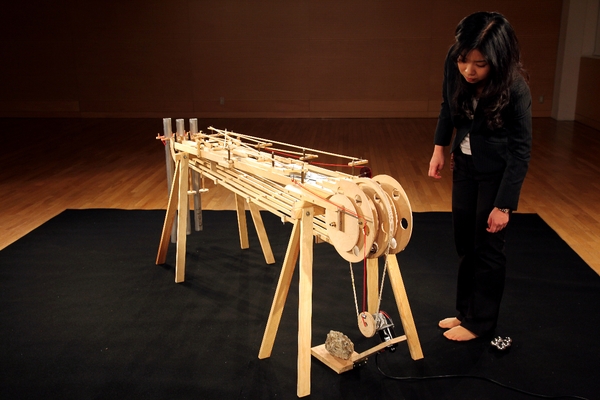
 Vimeo: A documentation by Kenichi Hagihara.
Vimeo: A documentation by Kenichi Hagihara.  YouTube, Part 1
YouTube, Part 1 YouTube, Part 2
YouTube, Part 2
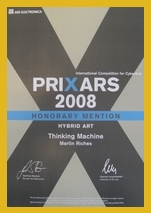
|
|
Masahiro entered our project for the Prix Ars Electronica in the hybrid art category and we got an honourable mention. |
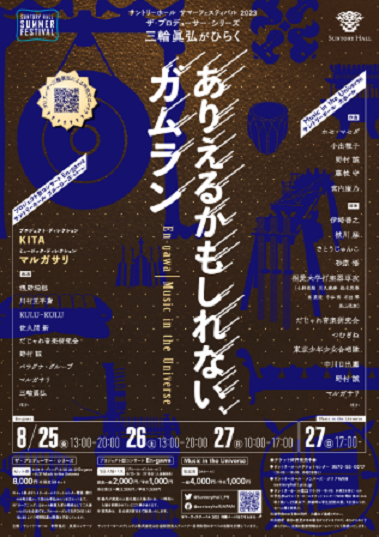 |
Suntory Hall, Tokyo 25th, 26th, 27th August, 2023 ◯ "Possible Gamelan" a composition and installation by Masahiro Miwa including time signals by the Thinking Machine on loan from the collection of the Komaba Museum, University of Tokyo |
 |
The Thinking Machine was converted to play three gamelan bars with resonators, by Yuichi Matsumoto Here, the hammers struck the instruments on the recoil, giving a softer sound. The machine played N:00 - once an hour, - on the hour. |